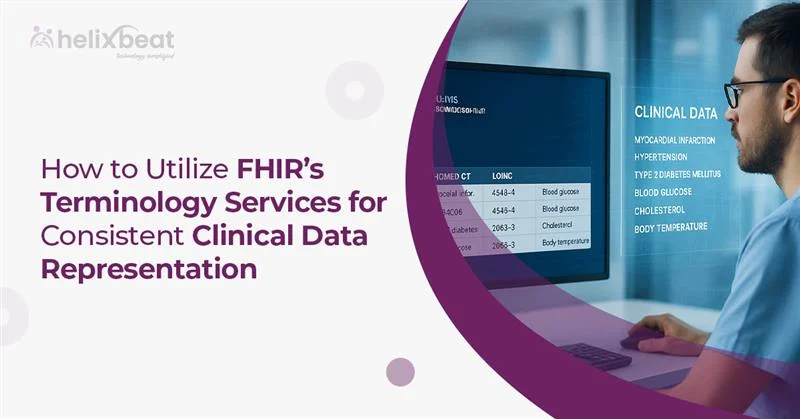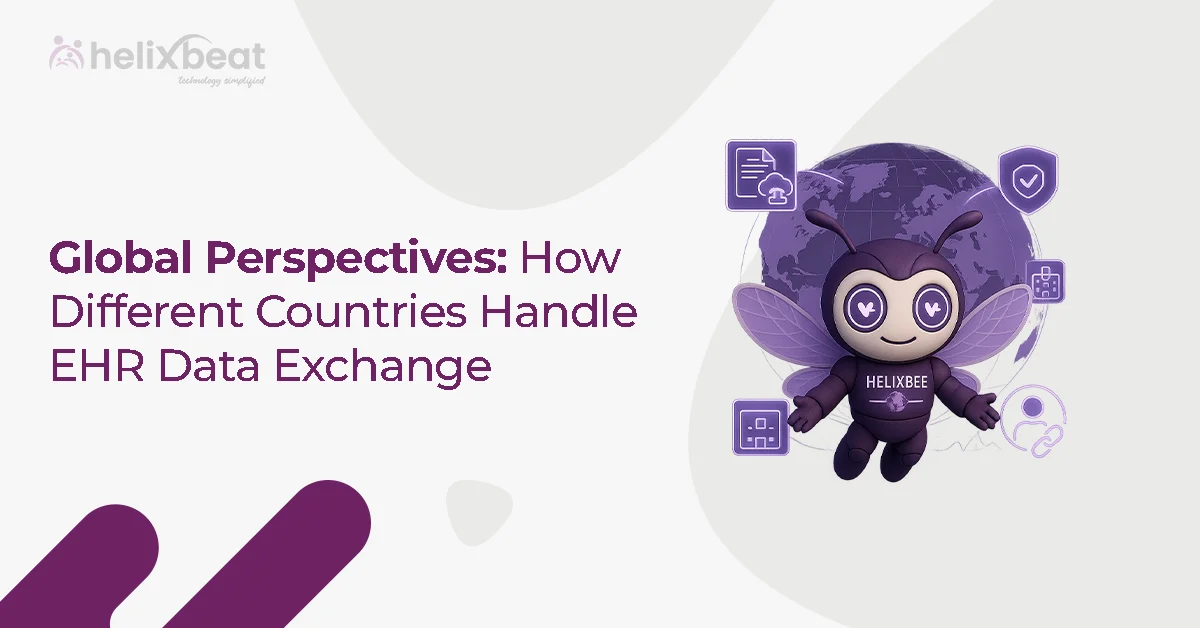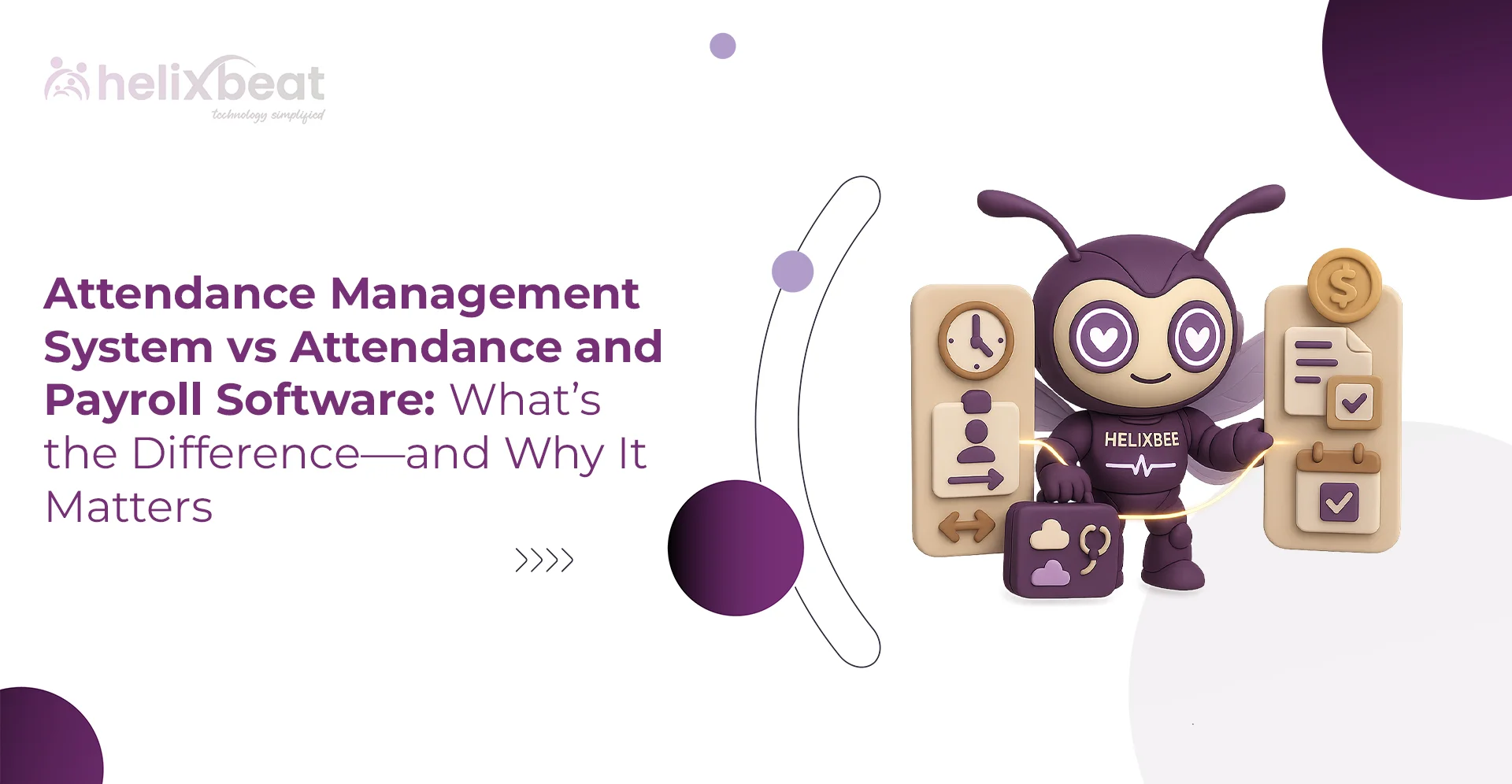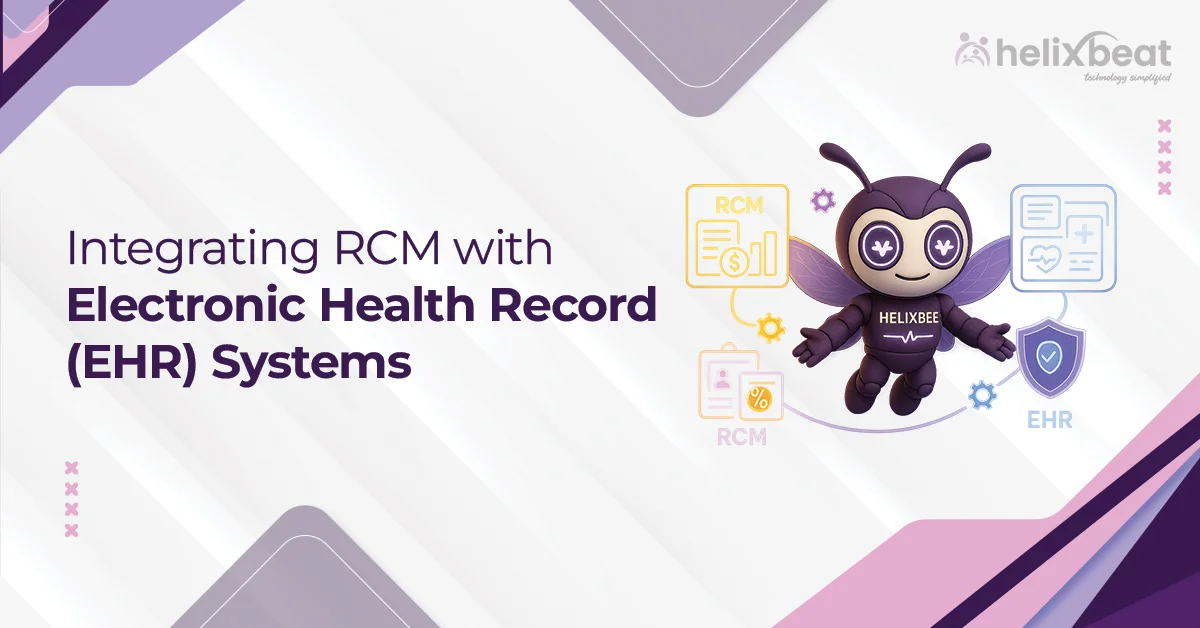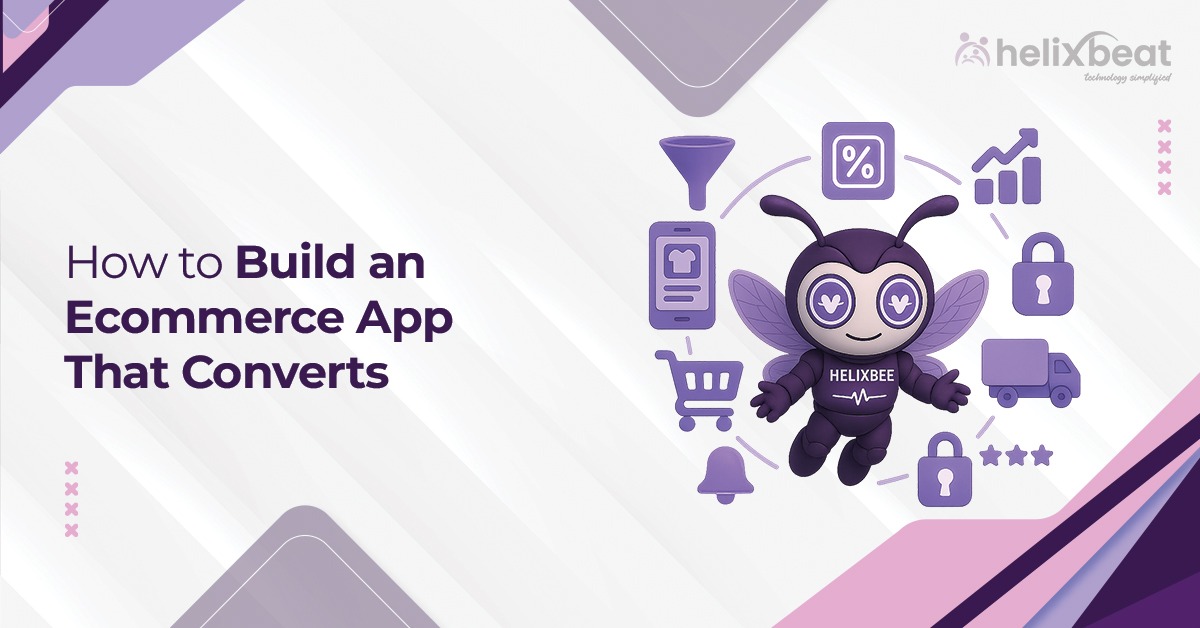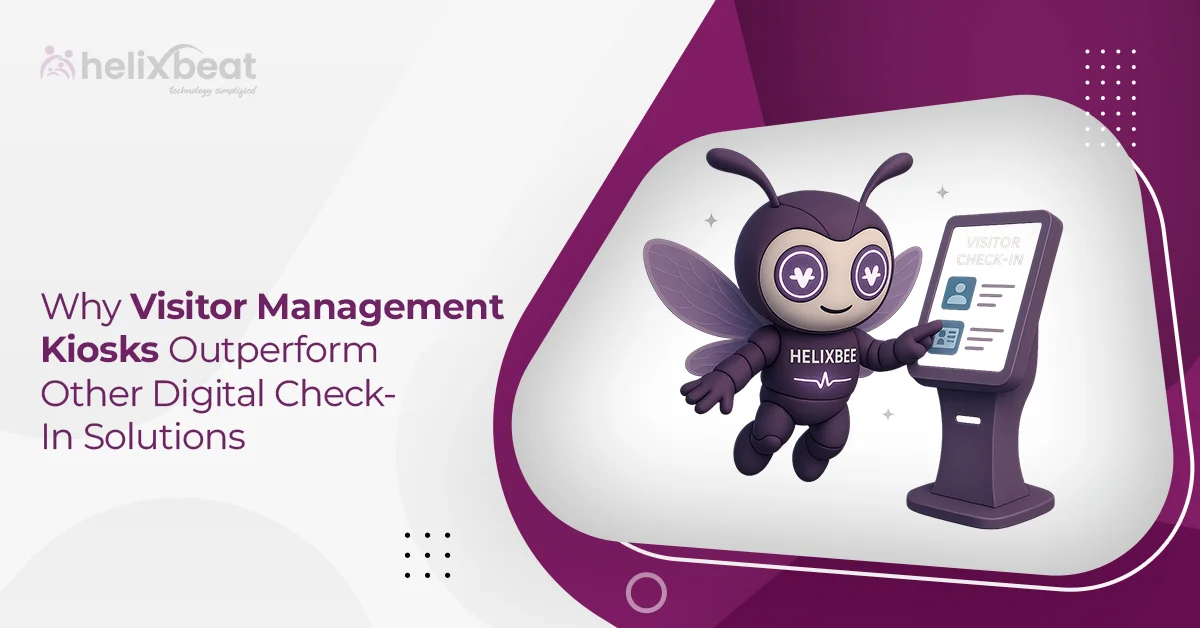When doctors, nurses, and labs use different words or codes to describe the same condition, things can get messy—and even dangerous. Imagine a patient visiting three different hospitals and each one recording her diagnosis in a different format. That’s where the need for consistent clinical data interoperability comes in. It’s not just about technology; it’s about making sure every patient’s story is understood the same way, no matter where they go.
That’s why standards like FHIR (Fast Healthcare Interoperability Resources) are transforming how healthcare data is shared. But FHIR does more than just move data—it helps speak the same clinical language through its FHIR’s Terminology Services. These tools ensure that everyone—from hospital systems to mobile health apps—understands and uses clinical terms consistently.
In this blog, we’ll explore how FHIR’s Terminology Services work, how to implement them effectively, and how Fusion’s Helixbeat can make this journey smoother and smarter for healthcare providers.
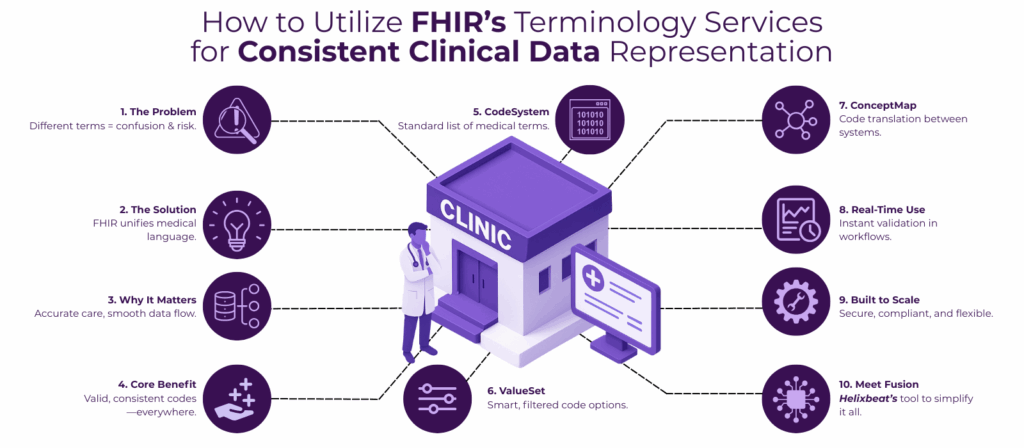
Table of Contents
Importance of consistent clinical data representation
Imagine a scenario where a patient’s diagnosis is recorded using one terminology system in a hospital’s EHR, but a different coding system is used when that same data is shared with a specialist’s clinic or a national health database. Without standardization, the data can be misinterpreted, lost in translation, or lead to errors in treatment.
Consistent clinical data representation ensures:
- Accuracy in diagnosis and treatment
- Reliable health data exchange
- Streamlined reporting and analytics
- Effective clinical decision support systems
- Improved patient safety and outcomes
By adopting common coding systems like SNOMED CT, LOINC, ICD-10, and RxNorm, and using a standardized terminology service such as FHIR, healthcare providers can ensure uniform understanding of clinical concepts across platforms and stakeholders.
One of its key features is FHIR’s Terminology Services. It helps to manage medical codes and ensure data is uniform across different platforms.
Many providers face challenges with inconsistent medical terminology across platforms. FHIR’s Terminology Services solves this issue by defining medical codes clearly. This ensures that all providers use the same standard codes.
FHIR and Its Terminology Services
FHIR, developed by HL7, is built on a modular set of “resources” that represent different healthcare concepts. Among its many capabilities, FHIR includes a powerful set of FHIR’s Terminology Services that provide mechanisms to work with coded data, like verifying if a code is valid, translating codes between systems, or identifying suitable codes for a specific clinical use case.
FHIR’s Terminology Services allow developers and healthcare systems to:
- Look up medical codes and display names
- Validate code systems and value sets
- Translate between different coding systems
- Expand value sets to identify acceptable code choices
- Check code relationships (hierarchies, subsumption)
These services provide the infrastructure needed for consistent, dynamic, and real-time interaction with medical terminologies.
The 3 Primary Resources of FHIR’s Terminology Services
FHIR’s Terminology Services consist of three important components:
1. CodeSystem – Standardizing Medical Codes
What It Is:
A CodeSystem is like the dictionary of medical language. It holds the official list of terms used for diseases, procedures, medications, and more—each with its own unique code.
Real-Life Example:
Consider SNOMED CT, which provides detailed codes such as “Diabetes mellitus type 2” (code: 44054006). Or LOINC, used for lab results—like a blood glucose test (code: 2345-7). And of course, there’s ICD-10, which every hospital uses for billing and insurance—like E11.9 for diabetes.
Why It Matters:
Let’s say a nurse in New York records a diagnosis using SNOMED CT, and a billing officer in Texas references ICD-10 for insurance. With CodeSystems, everyone’s on the same page. It reduces the risk of misdiagnosis, helps automate insurance claims, and keeps electronic health records (EHRS) clean and accurate.
2. ValueSet – Organizing and Validating Terminologies
What It Is:
A ValueSet is like a curated playlist of medical codes—handpicked from one or more CodeSystems. It narrows down choices for a specific purpose, making sure healthcare providers use the right terms in the right context.
Real-Life Example:
Suppose a doctor is filling out a digital form to record a patient’s symptoms for flu. The system shows a list of predefined options like “Fever,” “Cough,” “Fatigue”—all from a ValueSet. This ensures the doctor doesn’t type free-form text like “a bit tired,” which wouldn’t be helpful for future analysis.
Why It Matters:
ValueSets make forms smarter. Instead of scrolling through thousands of codes, providers get relevant options tailored to the situation—be it for symptoms, test results, or vaccine types. This minimizes mistakes, standardizes documentation, and speeds up workflows. It’s like autocomplete—but for critical medical data.
3. ConceptMap – Translating Between Systems
What It Is:
ConceptMap is the translator in the room. It maps codes from one CodeSystem to another, ensuring smooth data exchange between different software or hospitals using varied standards.
Real-Life Example:
Let’s say Hospital A uses SNOMED CT and Hospital B uses ICD-10. A ConceptMap can link “Hyperlipidemia” in SNOMED CT (code: 55822004) with the ICD-10 equivalent (E78.5). This way, if a patient’s record is transferred, the meaning remains clear—even if the underlying systems speak different “languages.”
Why It Matters:
Imagine two hospitals trying to share allergy data, but each uses a different coding standard. Without a ConceptMap, vital details could be lost—or worse, misinterpreted. Fusion prevent that. They ensure seamless clinical data interoperability, making sure health information retains its meaning across systems and borders.
Implementing FHIR’s Terminology Services in Healthcare Systems
At helixbeat, we believe consistent clinical data interoperability is not just a technical feature—it’s the foundation of accurate diagnoses, effective treatment, and smooth healthcare operations. To achieve this, FHIR’s Terminology Services must be integrated seamlessly into healthcare systems. When done right, this integration enhances efficiency, improves patient safety, and supports compliance across the board.
1. Integrating FHIR’s Terminology Services into EHRs and Clinical Workflows
Electronic Health Record (EHRs) are the heartbeat of modern healthcare systems. To ensure accurate and meaningful documentation, FHIR-based Terminology Services must be deeply woven into these workflows.
How it works with Fusion:
- When a doctor records a diagnosis or prescribes medication, the system pulls from standardized code sets like ICD-10, SNOMED CT, and LOINC.
- Real-time validation ensures terms are correct, current, and properly categorized.
- Clinical forms auto-populate with dropdowns linked to ValueSets, preventing inconsistent entries.
Example: A neurologist entering a diagnosis for epilepsy sees a structured list of valid SNOMED CT codes tailored to neurology. This not only speeds up entry but ensures other providers viewing the record later understand exactly what was diagnosed.
Why it matters:
When every provider in the network uses the same terminology, care becomes safer, billing becomes simpler, and communication between systems becomes seamless.
2. Using FHIR APIs for Real-Time Terminology Validation
FHIR provides robust APIs that allow clinical applications to perform real-time validation and terminology lookups as users interact with the system.
With Fusion’s implementation:
- If a clinician enters a code that’s outdated or invalid, the API flags it instantly.
- The system offers suggested alternatives from the correct CodeSystem or ValueSet.
- This happens instantly—without interrupting workflow or requiring IT support.
Example: A provider types in a medication abbreviation. The API recognizes it’s not a complete entry and suggests the full, valid term from the medication CodeSystem. The provider selects the right term with one click.
Benefits: This reduces the need for manual checks, minimizes coding errors, and ensures that records are standardized across departments and partner organizations.
3. Ensuring Scalability and Compliance
As healthcare networks grow and evolve, so does the volume and complexity of their data. Fusion’s FHIR Terminology Services are designed to scale with your needs—whether you’re a small clinic or a national hospital chain.
Built-in capabilities include:
- Scalable infrastructure that adapts to rising data volumes.
- Secure architecture with data encryption, user access control, and role-based permissions.
- Built-in compliance tools to align with regulations like HIPAA.
- Audit logs to trace when, how, and by whom terminology was accessed or updated.
Example: A large multi-specialty hospital onboards a new branch. Fusion enables seamless terminology integration across all facilities, ensuring the newly added location speaks the same “language” without manual syncing or downtime.
Why it’s essential:
Compliance isn’t just a checkbox—it protects patient data and preserves trust. Scalable FHIR’s terminology services ensure that as your system grows, data consistency and privacy remain intact.
4. Automating Terminology Updates
Medical terminology is not static—it evolves constantly. Whether due to medical discoveries, new treatments, or revised standards, the codes and terms healthcare providers rely on must be regularly updated.
Fusion simplifies this by automating terminology updates, so you always stay current without manual intervention.
How Fusion helps:
- Pulls the latest version of terminologies from authoritative sources (like SNOMED, ICD, LOINC).
- Updates are tested for consistency before being pushed to live systems.
- Users are notified of changes, but the transition remains smooth and transparent.
Example: Let’s say new classifications are introduced for a group of rare blood disorders. Fusion detects the update from the relevant CodeSystem and automatically integrates the new terms into the system, making them available for selection by hematologists.
Why it matters:
This keeps your clinical documentation accurate, future-ready, and regulation-friendly, without burdening your IT team with repetitive tasks.
Final thoughts
In healthcare, every word matters—especially when it comes to patient care. That’s why consistent clinical data interoperability is so important. Fusion, built on FHIR by Helixbeat, makes this consistency simple and seamless. It helps doctors, nurses, and healthcare systems all speak the same language, no matter where or how care is delivered. With real-time validation, smooth code updates, and effortless integration, Fusion takes the hassle out of managing complex medical terms.
If you are searching for the best interoperability service for your practice, Helixbeat’s fusion of FHIR’s terminology services is your choice. We can assist you by navigating all potential challenges and ensuring seamless healthcare data exchange.
Reach out to Helixbeat for your Healthcare Practice.
FAQs
1. What is HL7?
HL7 (Health Level Seven) is a set of international standards for the exchange, integration, sharing, and retrieval of electronic health information.
2. What is FHIR?
FHIR (Fast Healthcare Interoperability Resources) is a modern HL7 standard designed to simplify and accelerate the exchange of healthcare data using web technologies like RESTful APIs and JSON.
3. How is FHIR different from HL7 v2 and v3?
Unlike older HL7 versions (v2 and v3), FHIR uses modern web standards, is easier to implement, and is designed for mobile apps, cloud-based systems, and real-time data exchange.
4. Is FHIR a replacement for HL7?
FHIR is not a total replacement—it builds on HL7’s mission but offers a more flexible, developer-friendly way to exchange healthcare data.
5. Who created FHIR?
FHIR was developed by Health Level Seven International (HL7), the same organization behind earlier standards like HL7 v2 and CDA.
6. What are the benefits of using FHIR?
FHIR enables faster integration, supports real-time data sharing, improves patient data access, and enhances interoperability across healthcare systems.
7. Can HL7 and FHIR work together?
Yes, many systems use HL7 v2 or CDA for existing data exchange and adopt FHIR gradually for new applications, enabling hybrid interoperability strategies.



